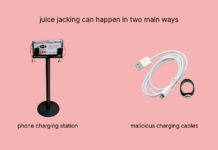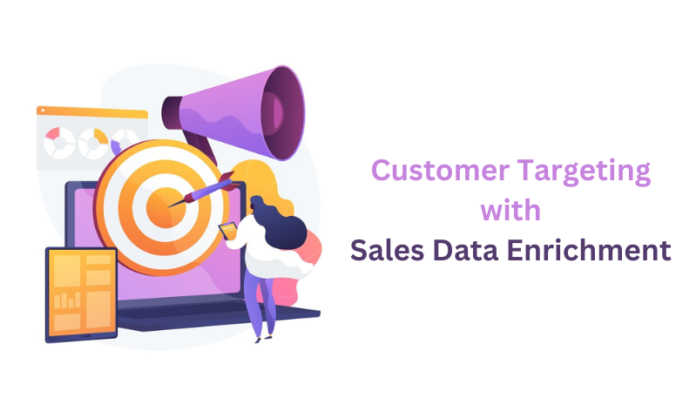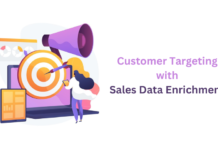Effective customer targeting is essential for successful marketing and sales initiatives, but this is easily compromised when businesses rely on incomplete, inaccurate or outdated sales data. From email campaigns with poor open rates to wasted advertising spend aimed at the incorrect audience segments, low-quality data can severely impair the ability to properly connect with prospective and current customers.
This is where sales data enrichment becomes pivotal. Businesses can append their existing data with fresh demographic, firmographic, behavioral, and intent information from third-party sources. With high-quality data at their access, businesses can target the right customers, increase the chances of conversion, foster stronger customer loyalty, and drive revenue growth.
Read through and explore how B2B data enrichment can help you build a more comprehensive view of your customers, enabling smarter segmentation and personalized outreach.
Improve Customer Targeting through Sales Data Enrichment: Here is How
1. Comprehensively Analyze your Current Data to Find Gaps
To effectively enrich sales data, it is essential to thoroughly analyze the existing data and identify areas needing enrichment. Start by examining various data fields to understand where information is lacking. Focus on details concerning one-time and recurring buyers, potential clients, and comprehensive sales data.
-
Detect Incomplete Profile Information:
Look for gaps in customer profiles, such as incomplete contact information, missing purchase histories, and other essential details. Identifying these gaps timely allows for targeted enrichment strategies.
-
Spot Inconsistencies in Sales and Customer Data:
Examine each transaction for missing or incorrect information, such as product descriptions, SKU numbers, prices, or payment methods. Any discrepancy can lead to a faulty understanding of customer behavior and purchasing patterns.
Identify inconsistencies within customer profiles, such as problems in contact details, such as different addresses or phone numbers for the same customer. Find whether demographic information, such as age, gender, and income level, is consistent across all customer segments. Inconsistent demographic data can affect the segmentation and targeting of marketing campaigns.
-
Identify Patterns and Trends:
Analyze current data to uncover patterns such as seasonal sales fluctuations, the primary channels through which purchases are made (online vs. offline), and peaks and valleys in buyer behavior.
-
Document your Findings:
Document all identified gaps, incomplete information, and quality issues meticulously. This documentation will serve as a foundation for accurate and timely B2B data enrichment for sales. Keeping a detailed record will also help in tracking progress and making future data audits more efficient.
2. Find and Gather Data for Enrichment
Once missing entries, inconsistencies, and errors in the sales data have been identified, the next step is to find and gather the necessary information to fill these gaps and make the most of your B2B data enrichment for sales.
-
Internal Data Sources:
Begin by exploring internal data sources. Seek information from various departments, such as customer service, finance, sales, and marketing. These departments often hold valuable data that can enrich your customer profiles. Cross-departmental collaboration can help uncover valuable data that may be hidden or not readily apparent within the organization and ensure a comprehensive data collection effort.
-
Direct Customer Engagement:
Engage directly with your customers through emails, surveys, or feedback forms. Gather information about their buying preferences, thoughts on competitors, and any other missing information. You can offer incentives to encourage higher response rates and more detailed input.
-
External Data Sources:
Utilize external sources to gather relevant information for B2B data enrichment. These can include industry reports, social media platforms, online directories, and market research studies. Conducting market research with specific focus groups can also provide valuable insights and help fill in data gaps.
3. Cleanse and Verify the Gathered Information
Before incorporating the newly gathered data into your system, it is crucial to cleanse and verify it to ensure its accuracy and relevance.
-
Error Correction:
Identify and correct errors such as misspellings or incorrect formatting of addresses, names, or email addresses. Implement automated data cleansing tools to streamline this process and minimize human error.
-
Accuracy and Relevance Check:
Ensure the accuracy and completeness of the collected information. Remove any data that is irrelevant to the enrichment process. Use data validation techniques to cross-check information against trusted sources and flag discrepancies for review.
-
Source Credibility:
Confirm the credibility of third-party sources from which data has been gathered. This step is essential to maintain the integrity of your data. Establish criteria for source reliability and document this process for future reference.
-
Stakeholder Updates:
Regularly update and consult with relevant stakeholders involved in the data gathering process to resolve any conflicts or discrepancies about the newly gathered information. Frequent communication ensures that all parties are aligned and that the data enrichment process runs smoothly.
4. Enrich your Database with the Gathered Information
With cleansed and verified data in hand, the next step is to enrich your existing database.
-
In-House Enrichment:
Append existing customer profiles in your CRM system with newly gathered information like demographic details, contact numbers, email addresses, etc. Fill in any missing purchase details, such as the date and time of purchase, shipping information, payment methods, and quantities purchased. Accurate purchase histories are crucial for understanding customer behavior and improving inventory management.
Add information about the most popular sales channels, such as mobile apps, websites, and other platforms. Include data related to the sources generating the highest leads, including email marketing campaigns, social media ads, PPC ads, or referral programs. Detailed attribution data helps in optimizing marketing spend and targeting efforts more effectively.
-
Outsource Data Enrichment:
If managing the data enrichment process in-house seems challenging due to the complexity and volume of data, consider outsourcing this task to a specialized B2B data enrichment company.
Recently a U.S. based water technology firm faced challenges in engaging potential clientele due to outdated and incomplete CRM data. Despite considerable investments, their email marketing initiatives resulted in unsatisfactory outcomes. Recognizing this, the company chose to outsource data enrichment to refine and enhance their sales data for more targeted outreach. The resultant enriched dataset led to a notable 39% increase in their email delivery rates and an impressive 52% surge in overall sales.
Experts can handle the intricacies of data collection, cleansing, and verification, ensuring a high-quality and comprehensive enrichment process. Moreover, they opt for a human-in-the-loop approach to enrich your data. By leveraging both automated tools and human expertise, these specialists provide valuable oversight for verification, ensuring data accuracy. This approach not only improves the quality and reliability of your data but also frees up valuable resources, enabling your team to concentrate on core tasks like refining customer targeting strategies and driving business growth.
5. Integrate the Enriched Data
After enriching your database, it is crucial to integrate this data seamlessly into your existing systems to maximize its utility.
-
Data Integration Planning:
Develop a comprehensive integration plan outlining the steps and resources required to merge the enriched data with your existing databases. This plan should include timelines, responsible personnel, and key performance indicators (KPIs) to measure the success of the integration process.
-
System Compatibility:
Ensure that the enriched data is compatible with your current CRM and other business systems. This may involve updating software, adjusting data schemas, or implementing middleware solutions to facilitate smooth data flow.
-
Automated Integration Tools:
Utilize automated data integration tools to streamline the process. These tools can help synchronize data across various platforms in real time, reducing the chances of errors and ensuring that your team always has access to the most current information.
-
Testing and Validation:
Conduct thorough testing to ensure that the enriched data has been integrated correctly. Validate the data by running sample queries and reports to check for accuracy and consistency. Address any issues promptly to prevent data discrepancies.
-
Monitor and Refine:
Continuously monitor the performance of the integrated data and refine the process as needed. Regular audits and feedback from users can help identify areas for improvement and ensure that the data remains accurate and valuable over time.
6. Utilize Enriched Data for Smarter Customer Targeting
Once your sales data has been thoroughly enriched and integrated, it becomes a powerful asset for targeting the right customers with personalized marketing strategies.
-
Segmentation and Targeting:
Utilize the enriched data to segment your customer base more comprehensively. By categorizing customers based on demographics, purchase history, behavior patterns, and preferences, you can tailor your marketing messages and offers to resonate with specific audience segments.
-
Personalized Communication:
Use the enriched data to craft personalized communication and marketing campaigns. Address customers by name, recommend products or services based on their past purchases, and provide relevant content that aligns with their interests and needs. Personalization enhances customer engagement and fosters loyalty by displaying that you understand and value their individual preferences.
-
Channel Selection:
Use enriched data to identify the most effective channels for reaching different customer segments. Whether it’s email marketing, social media advertising, direct mail, or targeted online campaigns, selecting the right channels based on accurate data ensures that your messages are delivered where they are most likely to be seen and acted upon.
-
Timing and Frequency Optimization:
Analyze enriched data to determine the optimal timing and frequency for engaging with customers. By understanding their behavior patterns and preferences, you can send communications at the times when they are most likely to make a purchase and avoid overwhelming them with excessive messaging.
To Conclude
Prioritizing sales data quality is undeniable for businesses. By following the steps outlined above, companies can enrich their data, increase their understanding of target customers, refine their marketing efforts, and drive overall business growth.
Regardless of whether it’s done internally or with the help of a data enrichment company, the main goal remains the same: to access the most important information for understanding and serving customers. Thus, businesses considering data enrichment can deliver higher customer satisfaction, execute smarter marketing campaigns, and experience continued business success.





















